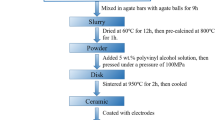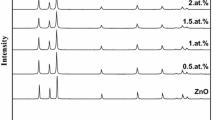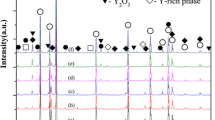Abstract
Zn0.99−xCo0.01PrxO (x = 0, 0.005, 0.015 and 0.020) nanoparticles for varistor application have been synthesized by sol–gel method. The phase and microstructure of the as-prepared samples were characterized by X-ray diffraction, transmission electron microscopy, scanning electron microscopy and energy dispersive X-ray spectra. The results reveal that the samples exhibited hexagonal zinc oxide (ZnO) lattice structure without secondary phases and were well crystallized with preferential orientation towards (101) direction. The calculated average crystalline size decreases from 39.9312 to 39.3605 nm when Pr3+ content increased from 0 to 2 at.%. The microstructure of Zn0.99−xCo0.01PrxO (x = 0.02) varistors ceramics consisted of ZnO grain as a primary phase and Pr-rich phase (Pr6O11) and spinel phase (Pr2CoO4) as minor secondary phase. The breakdown field increased over a wide range from 2332 to 7845 V/cm with the Pr3+ content increasing. The varistors doped with 1.5 at.% Pr3+ exhibited the highest nonlinear coefficient of 17.9. Further increase caused nonlinear coefficient decreased to 15.4 at 2 at.%. The current–voltage (E–J) characteristics curves indicated the Pr–Co co-doped ZnO varistors showed good electrical properties and could be a promising material to replace ZnO–Bi2O3 varistors which is appreciable for the fabrication of voltage switching devices in the near future.






Similar content being viewed by others
References
H. Chettah, D. Abdi, Effect of the electrochemical technique on nanocrystalline ZnO electrodeposition, its structural, morphological and photoelectrochemical properties. Thin Solid Films 537, 119–123 (2013)
A. Franco Jr., H.V.S. Pessoni, Enhanced dielectric constant of Co-doped ZnO nanoparticulate powders. Physica B 476, 12–18 (2015)
M.M. Jumidali, M.R. Hashim, Modified thermal evaporation process using GeO2 for growing ZnO structures. Superlattices Microstruct. 52, 33–40 (2012)
R. Yousefi, B. Kamaluddin, Dependence of photoluminescence peaks and ZnO nanowires diameter grown on silicon substrates at different temperatures and orientations. J. Alloys Compd. 479, L11–L14 (2009)
M.M. Mikhailov, V.V. Neshchimenko, N.V. Dedov, C. Li, S. He, Proton and electron irradiation induced changes in the optical properties of ZnO pigments modified with ZrO2 and Al2O3 nanopowders. J. Surf. Investig. X-Ray, Synchrotron Neutron Tech. 5, 1152–1161 (2011)
T. Shibata, K. Unno, E. Makino, Y. Ito, S. Shimada, Characterization of sputtered ZnO thin film as sensor and actuator for diamond AFM probe. Sens. Actuators, A 102, 106–113 (2002)
P. Amornpitoksuk, S. Suwanboon, S. Sangkanu, A. Sukhoom, N. Muensit, Morphology, photocatalytic and antibacterial activities of radial spherical ZnO nanorods controlled with a diblock copolymer. Superlattices Microstruct. 51, 103–113 (2012)
K. Matsubara, P. Fons, K. Iwata, A. Yamada, K. Sakurai, H. Tampo, S. Niki, ZnO transparent conducting films deposited by pulsed laser deposition for solar cell applications. Thin Solid Films 431–432, 369–372 (2003)
M. Vishwas, K.N. Rao, K.V.A. Gowda, S.R.P. Chakradhar, Optical, electrical and dielectric properties of TiO2–SiO2 films prepared by a cost effective sol–gel process. Spectrochim. Acta A 83, 614–617 (2011)
H. Feng, Z. Peng, X. Fu, Z. Fu, C. Wang, L. Qi, H. Miao, Effect of SnO2 doping on microstructural and electrical properties of ZnO–Pr6O11 based varistor ceramics. J. Alloys Compd. 509, 7175–7180 (2011)
C.-W. Nahm, Effect of sintering temperature on microstructure and electrical properties of Zn·Pr·Co·Cr·La oxide-based varistors. Mater. Lett. 60, 3394–3397 (2006)
L.M. Levinson, H.R. Philipp, Zinc oxide varistors. Am. Ceram. Soc. Bull. 65, 639–646 (1986)
T.K. Gupta, Application of zinc oxide varistors. J. Am. Ceram. Soc. 73, 1817–1840 (1990)
Y.-S. Lee, T.-Y. Tseng, Phase identification and electrical properties in ZnO–glass varistors. J. Am. Ceram. Soc. 75, 1636–1640 (1992)
E.D. Kim, C.H. Kim, M.H. Oh, Role and effect of Co2O3 additive on the upturn characteristics of ZnO varistors. J. Appl. Phys. 58, 3231–3235 (1985)
K. Hembram, D. Sivaprahasam, T.N. Rao, Combustion synthesis of doped nanocrystalline ZnO powders for varistors applications. J. Eur. Ceram. Soc. 31, 1905–1913 (2011)
C.-W. Nahm, Effect of sintering temperature on nonlinear electrical properties and stability against DC accelerated aging stress of (CoO, Cr2O3, La2O3)-doped ZnO–Pr6O11-based varistors. Mater. Lett. 60, 3311–3314 (2006)
K. Mukae, Zinc oxide varistors with praseodymium oxide. Am. Ceram. Soc. Bull. 66, 1329–1331 (1987)
C.-W. Nahm, B.-C. Shin, J.-A. Park, D.-H. Yoo, Effect of CoO on nonlinear electrical properties of praseodymia-based ZnO varistors. Mater. Lett. 60, 164–167 (2006)
A. Khorsand Zak, R. Yousefi, W.H.A. Majid, M.R. Muhamad, Facile synthesis and X-ray peak broadening studies of Zn1–xMgxO nanoparticles. Ceram. Int. 38, 2059–2064 (2012)
C. Li, H. Liang, J. Zhao, Q. Feng, J. Bian, Y. Liu, R. Shen, W. Li, G. Wu, G.T. Du, Influence of high-pressure hydrogen treatment on structural and electrical properties of ZnO thin films. Appl. Surf. Sci. 256, 6770–6774 (2010)
D. Anbuselvan, S. Muthukumaran, Defect related microstructure, optical and photoluminescence behaviour of Ni, Cu co-doped ZnO nanoparticles by co-precipitation method. Opt. Mater. 42, 124–131 (2015)
W. Long, J. Hu, J. Liu, J. He, Effects of cobalt doping on the electrical characteristics of Al-doped ZnO varistors. Mater. Lett. 64, 1081–1084 (2010)
T. Yamaguchi, N. Mukouyama, T. Fujita, S. Taruta, K. Kitajima, Low-temperature formation of α-alumina from various polyhydroxoaluminum–hydroxy acid composite gels. Ceram. Int. 37, 201–206 (2011)
Acknowledgements
This work was financially supported by Changzhou Science, Technology Innovation Project, Production-Teaching-Research Project of Changzhou University Institute of Huaide, Nature Science Foundation of China (CC20150033, CDHK060007, No. 51273027) and 2015 Research and Innovation Project for College Graduates of Jiangsu Province.
Author information
Authors and Affiliations
Corresponding author
Rights and permissions
About this article
Cite this article
Sun, WJ., Yang, R., Qu, X. et al. Microstructure and varistor properties of Pr–Co co-doped ZnO ceramics obtained by sol–gel method. J Mater Sci: Mater Electron 28, 10166–10172 (2017). https://doi.org/10.1007/s10854-017-6780-2
Received:
Accepted:
Published:
Issue Date:
DOI: https://doi.org/10.1007/s10854-017-6780-2




